RON HENGGELER |
November 3, 2017
The historic ships at the Hyde Street Pier in San Francisco
Dave and I recently visited the Hyde Street Pier Historic Ships Museum in San Francisco.
Self portrait in the mirror on the front porch at home |
||||||||||||||||
Aquatic Park on the San Francisco Waterfront, across from Ghirardelli Square |
||||||||||||||||
Alcatraz Island as seen from the Aquatic Park |
||||||||||||||||
The Aquatic Park Lagoon with the historic ships and the Hyde Street Pier in the distance |
||||||||||||||||
A view of the Hyde Street Pier and the schooner C. A. Thayer seen from the beachhead near the Dolphin Club |
||||||||||||||||
Placard at the entrance to the Hyde Street Pier |
||||||||||||||||
Placard at the entrance to the Hyde Street Pier |
||||||||||||||||
The Petaluma's sternwheel and a Steam Donkey engine |
||||||||||||||||
Steam Donkey engines like this one were common along the waterfront from the 1880's into the 1920's. These portable steam winches were used as auxiliary power for loading and unloading cargo. The name "donkey" comes from the fact that the engines replaced horses as a power source for cargo handling. |
||||||||||||||||
|
||||||||||||||||
The Petaluma's sternwheelThe Petaluma, built in 1914, was the last of the San Francisco riverboats. Running between San Francisco and Petaluma, the sternwheeler Petaluma made over 10,000 trips over the 36-mile route. She carried passangers and served the chicken ranches for which Petaluma is famous. Petaluma's shallow hull and sternwheel remained useful on the Petaluma River long after her sisters had quit the major rivers. Finally retired in 1950, she was exhibited in Oakland until she burned and sank in 1956."After 35 years, 8 months and 10 days we tie up for good. This ends 103 years of stern wheel navigation of S.F. Bay and tributaries. John H. Urton, Master"
|
||||||||||||||||
The Petaluma's sternwheel |
||||||||||||||||
|
||||||||||||||||
A view of the historic ships from the beach in front of the Dolphin Club. |
||||||||||||||||
1895 schooner C. A. ThayerThe C.A. Thayer is a wooden-hulled, three-masted schooner, designed for carrying lumber.
|
||||||||||||||||
A workshop at the Hyde Street Pier |
||||||||||||||||
|
||||||||||||||||
Placard on the wall in the men's room at the Hyde Street Pier |
||||||||||||||||
|
||||||||||||||||
|
||||||||||||||||
|
||||||||||||||||
|
||||||||||||||||
|
||||||||||||||||
Hyde Street PierLocated at the west end of Fisherman's Wharf, Hyde Street Pier is home to the fleet of historic landmark vessels in the collection of the San Francisco Maritime National Historical Park, which is a unit of the National Park System. |
||||||||||||||||
|
||||||||||||||||
1895 schooner C. A. Thayer |
||||||||||||||||
|
||||||||||||||||
|
||||||||||||||||
On the deck of the 1895 schooner C. A. Thayer |
||||||||||||||||
C. A. Thayer
|
||||||||||||||||
C. A. Thayer |
||||||||||||||||
C. A. ThayerC.A. Thayer HistoryLumber SchoonerIn 1895, Danish-born Hans D. Bendixsen built C.A. Thayer in his Northern California shipyard (located across the narrows of Humboldt Bay from the city of Eureka). She was named for Clarence A. Thayer, a partner in the San Francisco-based E.K. Wood Lumber Company.Between 1895 and 1912, Thayer usually sailed from E.K. Wood's mill in Grays Harbor, Washington, to San Francisco. But she also carried lumber as far south as Mexico, and occasionally even ventured offshore to Hawaii and Fiji.Thayer is fairly typical of West Coast, three-masted lumber schooners in size (219' extreme) and cargo capacity (575,000 board feet). She carried about half of her load below; the remaining lumber was stacked ten feet high on deck, and secured with chain (as illustrated in this 1912 photo). In port, her small crew (eight or nine men) served double-duty as longshoremen; unloading 75,000 to 80,000 board feet was an average day's work.After sustaining serious damage during a heavy, southeasterly gale, C.A. Thayer's lumber trade days ended in an Oakland shipyard, in 1912. But it was really the rise of steam power, and not the wind, that pushed her into a new career.Exerpt from: National Park Service San Francisco Maritime |
||||||||||||||||
C. A. Thayer |
||||||||||||||||
On the deck of the C. A. Thayer with a view of the 1914 paddlewheel tug Eppleton Hall |
||||||||||||||||
The foremast of the C. A. Thayer |
||||||||||||||||
The foremast of the C. A. Thayer |
||||||||||||||||
The bow and bowsprit of the C. A. Thayer |
||||||||||||||||
The foremast of the C. A. Thayer |
||||||||||||||||
On the deck of the C. A. Thayer with a view of the 1890 steam ferryboat Eureka |
||||||||||||||||
The mainmast (foreground) and foremast of the C. A. Thayer |
||||||||||||||||
|
||||||||||||||||
C. A. Thayer |
||||||||||||||||
C. A. Thayer |
||||||||||||||||
C. A. Thayer The CA Thayer is a wooden-hulled, three-masted schooner, designed for carrying lumber.
|
||||||||||||||||
The entrance to 1890 steam ferryboat Eureka |
||||||||||||||||
A view of the distant Transamerica and Salesforce Tower as seen from the entrance to 1890 steam ferryboat Eureka |
||||||||||||||||
Inside the 1890 steam ferryboat Eureka♦ Eureka is a wooden-hulled, sidewheel paddle steamboat.
|
||||||||||||||||
Inside the Eureka |
||||||||||||||||
Inside the 1890 steam ferryboat Eureka |
||||||||||||||||
Inside the 1890 steam ferryboat Eureka |
||||||||||||||||
Eureka History
Exerpt from: National Park Service San Francisco Maritime |
||||||||||||||||
Inside the 1890 steam ferryboat Eureka |
||||||||||||||||
A view of the 1907 steam tug Hercules from the stern of the Eureka |
||||||||||||||||
Inside the 1890 steam ferryboat EurekaEureka's Statistics
|
Overall Length |
299.5 feet |
Extreme Width |
78 feet |
Gross Tonnage |
2,420 |
Horsepower |
1500 |
Passengers |
2300 souls |
Automobiles |
120 |
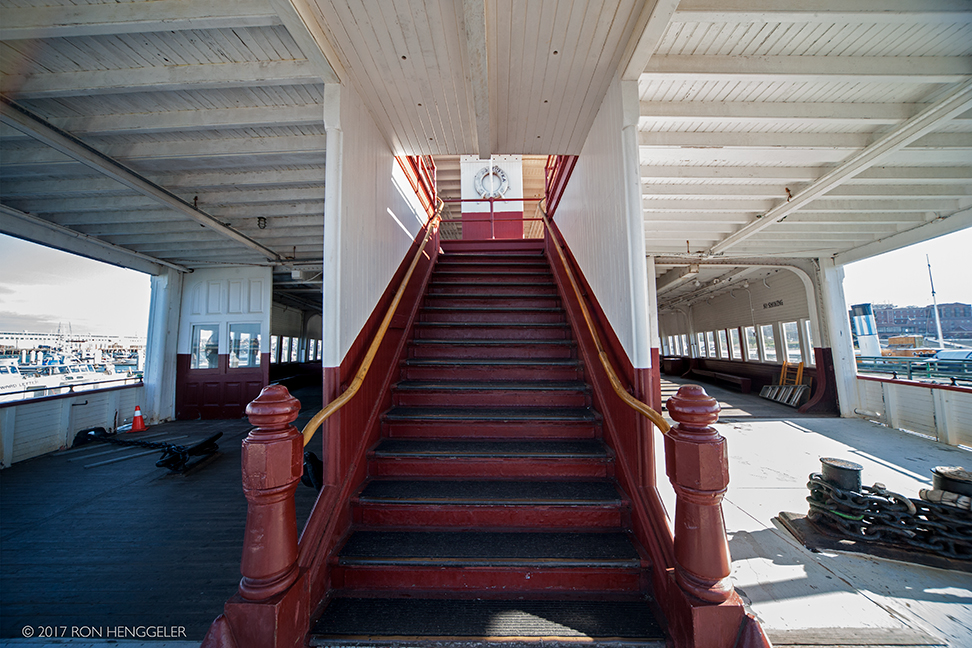

The stairs leading up to the top deck of the 1890 ferryboat Eureka

Steam Ferryboats on San Francisco Bay
The Bay's first steam ferry (the tiny Sitka) arrived in 1847, stowed aboard a Russian cargo ship. But the ferry, Kangaroo, made the first regularly scheduled crossings in 1850.
After Mexico ceded California to the United States in 1848 (and John Marshall discovered gold in the American River) the Bay Area's population exploded. It is said that San Francisco's Ferry Building was once second only to London's Charing Cross Railway Station as the busiest passenger terminal in the world.
At one time, Southern Pacific Railroad operated forty-two ferryboats on the Bay (they transported 50,000,000 passengers per year). Construction of the Bay and Golden Gate bridges (mid 1930s) signaled the end of the ferryboat era, however.
In 1941, Eureka had the dubious distinction of making the last Marin County run, and by the 1950s regular ferry service was limited to railroad connections.
Eureka kept working, but in 1957, when her crankpin snapped in mid-crossing, she was removed from service. Just one year later, the San Leandro made the last transbay ferryboat run.
Exerpt from: National Park Service San Francisco Maritime

A view of the 1907 steam tug Hercules ,from the top deck on the stern of the Eureka

Inside the Eureka

Inside the Eureka
The Walking Beam Engine
Eureka's tall "walking beam" is the last working example of an engine-type once common on America's waterways. Manufactured by Fulton Iron Works of San Francisco, this engine remains unaltered to this day.
Oil was burned in boilers to produce the steam, which drove a huge, vertical piston. Perched atop the engine, the walking beam changed this up-and-down motion into rotary motion via a connecting rod linked directly to the paddlewheel shaft. The twin paddlewheels (each twenty-seven feet in diameter) made twenty-four revolutions per minute.
Exerpt from: National Park Service San Francisco Maritime

Inside the Eureka



Restoration
In February of 1994, Eureka exited San Francisco Drydock after a $2.7 million restoration project. The steamship had been in the shipyard since October, where a crew of 45 skilled craftsmen caulked 2.5 miles of planking seams, and hammered in over 9000 eight-inch spikes. They applied stockholm tar, laid Irish Felt, and then plated the hull with 12,000 square feet of shining copper (cut down from modern dimensions to traditional-sized pieces to maintain the historical facade).
The vessel had suffered from rot in the edges of her main deck, and the caulking between her four-inch thick hull planks had softened. The immense beams holding up her paddle wheels and paddle boxes had deteriorated, and were replaced with steel. The overhanging ends and sides of the ferry were also repaired. To prevent the recurrence of rot, borate rods have been installed in all the new timbers. This is cutting edge preservation technology, pioneered by the park to treat its other ships. Over time, rainwater intrusion (a primary cause of dry rot) causes the rods to dissolve, and the borate leaches out into the wood, preventing rot from taking hold.
October of 1999, Eureka entered San Francisco Drydock for a $1 million restoration project focusing on the vessel’s superstructure -- the above-water portions of the vessel. A significant portion of that drydock was the replacement of the boat’s "kingposts" -- four large wooden structures which support the paddlewheels and upper decks.
Exerpt from: National Park Service San Francisco Maritime

A view of Fisherman's Wharf from the top deck of the Eureka


Interior of the top deck of the Eureka



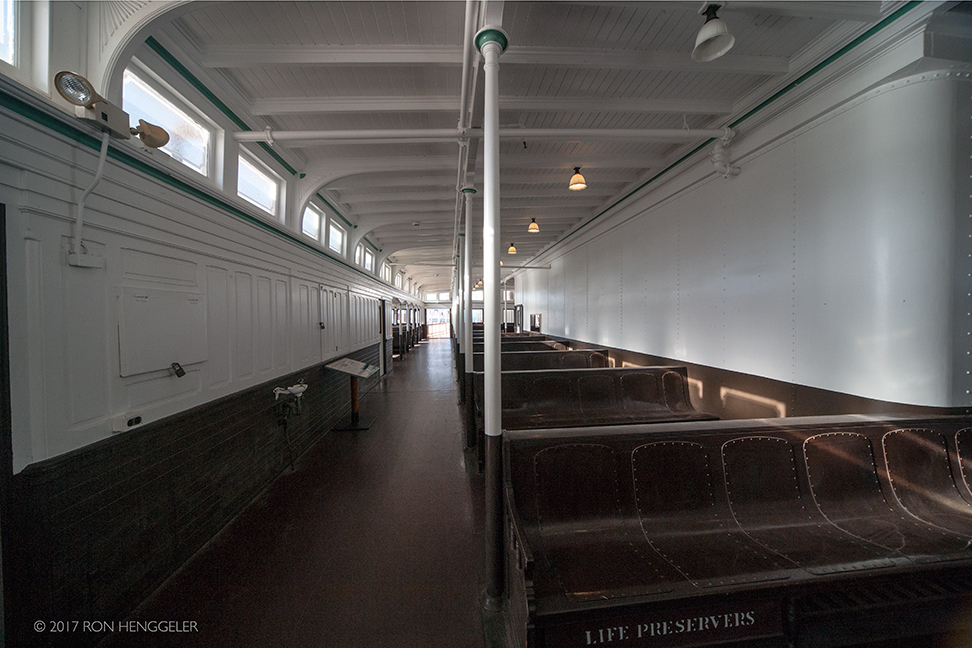
Interior of the top deck of the Eureka

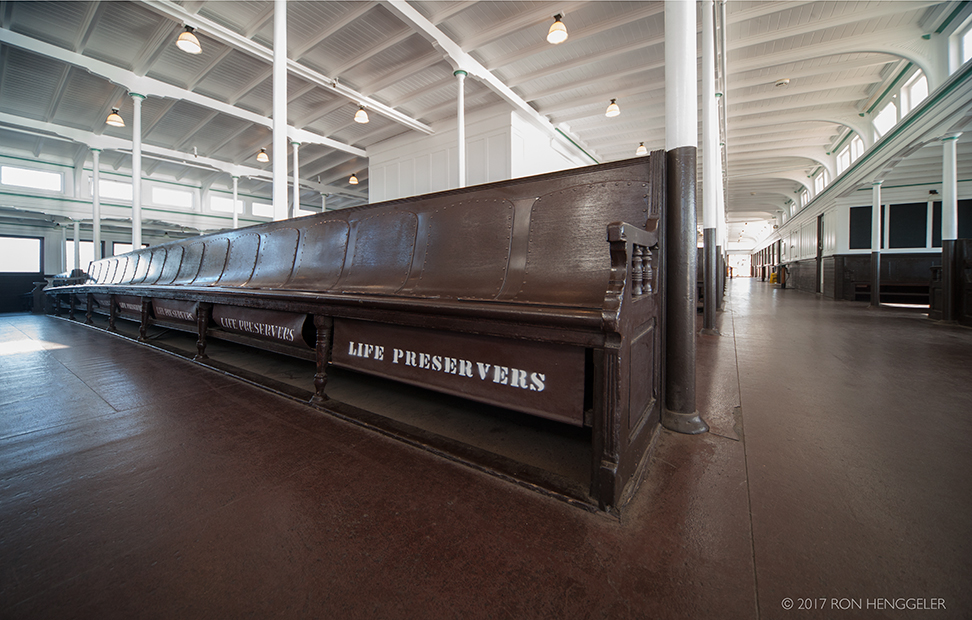
Interior of the top deck of the Eureka



Outside on the top deck of the Eureka


Interior of the Eureka



Interior of the Eureka
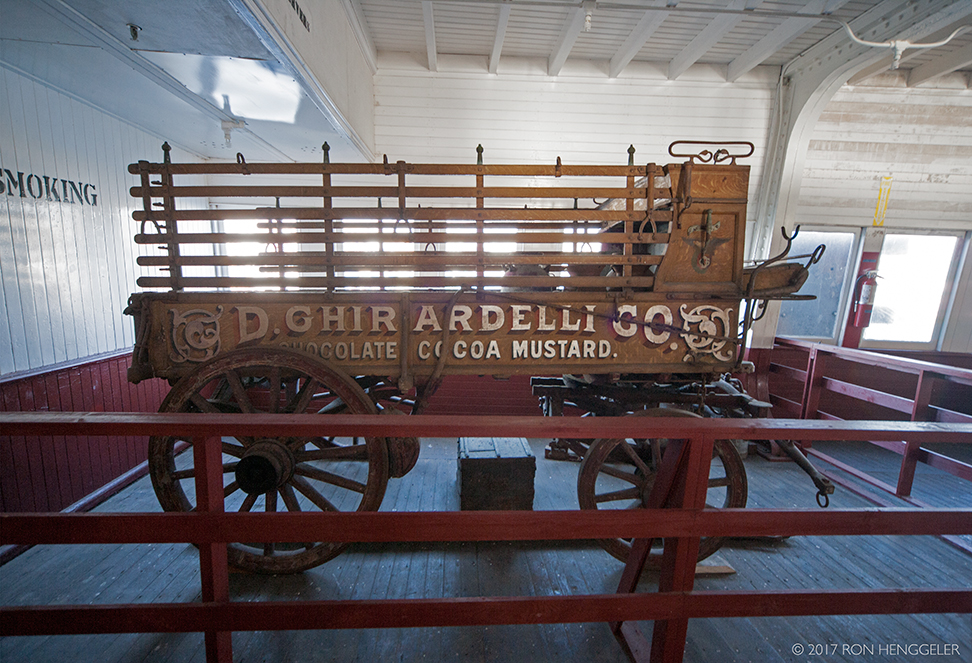


The Eureka

On the deck of the 1895 schooner C. A. Thayer

CA Thayer History
Lumber Schooner
In 1895, Danish-born Hans D. Bendixsen built C.A. Thayer in his Northern California shipyard (located across the narrows of Humboldt Bay from the city of Eureka). She was named for Clarence A. Thayer, a partner in the San Francisco-based E.K. Wood Lumber Company.
Between 1895 and 1912, Thayer usually sailed from E.K. Wood's mill in Grays Harbor, Washington, to San Francisco. But she also carried lumber as far south as Mexico, and occasionally even ventured offshore to Hawaii and Fiji.
Thayer is fairly typical of West Coast, three-masted lumber schooners in size (219' extreme) and cargo capacity (575,000 board feet). She carried about half of her load below; the remaining lumber was stacked ten feet high on deck, and secured with chain (as illustrated in this 1912 photo). In port, her small crew (eight or nine men) served double-duty as longshoremen; unloading 75,000 to 80,000 board feet was an average day's work.
After sustaining serious damage during a heavy, southeasterly gale, C.A. Thayer's lumber trade days ended in an Oakland shipyard, in 1912. But it was really the rise of steam power, and not the wind, that pushed her into a new career.
Exerpt from: National Park Service San Francisco Maritime

Restoration of the C. A. Thayer
The State of California purchased C.A. Thayer in 1957. After preliminary restoration in Seattle, Washington, an intrepid volunteer crew sailed her down the coast to San Francisco. The San FranciscoMaritimeMuseum performed more extensive repairs and refitting, and opened Thayer to the public in 1963. The vessel was transferred to the National Park Service in 1978, and designated a National Historic Landmark in 1984. After three full careers, and over 100 hundred years, she remains -- restored and maintained for future generations -- to be experienced at the San Francisco Maritime National Historical Park.
Exerpt from: National Park Service San Francisco Maritime
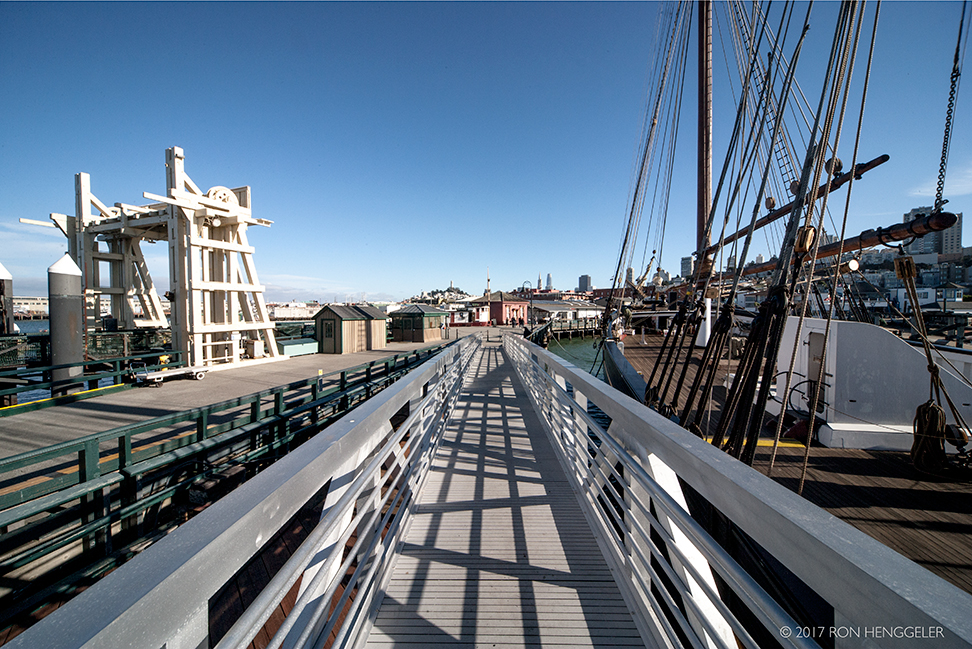


1907 steam tug Hercules

-
Hercules is a steam powered tug built for ocean towing.
-
The 151-foot ship, of riveted steel construction, still contains her original triple expansion steam engine.
-
Built on the East Coast in 1907, she towed her sister ship from Camden, New Jersey around South America to San Francisco.
- From: National Park Service San Francisco Maritime

-
Hercules also towed sailing ships, disabled vessels, barges, log rafts, a cassion (a steel structure used for closing the entrance to locks) for a dry dock at Pearl Harbor, and a caisson to help build a Panama Canal lock.
-
The tug usually carried a crew of three firemen, three oilmen, a chief and two assistant engineers, three deckhands, cook, two mates and a captain.
From: National Park Service San Francisco Maritime

HERCULES Statistics
Length |
151 feet |
Beam |
26 feet |
Draft |
18 feet aft, 10 feet forward |
Gross Tonnage |
409 |
Engine |
3 cylinder, triple expansion |
Cylinders |
17", 24", and 41" with 30" stroke. 500 Indicated Horsepower (ihp) |
Fuel Type |
Bunker C oil |
Boiler |
Scotch marine fire tube. 16' diameter, 11' 9" long. Four oil-burning furnaces |


Engine room of the Hercules





The kitchen of the Hercules

The kitchen of the Hercules






1907 steam tug Hercules


detail of the helm of the 1907 steam tug Hercules



The Transamerica Pyramid and the Salesforce Tower as viewed from the Hyde Street Pier



David, outside a Hyde Street Pier souvenir shop on Jefferson Street

Lucas
a homeless man panhandling in front of the Hyde Street Pier
Newsletters Index: 2017, 2016, 2015, 2014, 2013, 2012, 2011, 2010, 2009, 2008, 2007, 2006
Photography Index | Graphics Index | History Index
Home | Gallery | About Me | Links | Contact
© 2017 All rights reserved
The images are not in the public domain. They are the sole property of the
artist and may not be reproduced on the Internet, sold, altered, enhanced,
modified by artificial, digital or computer imaging or in any other form
without the express written permission of the artist. Non-watermarked copies of photographs on this site can be purchased by contacting Ron.




























































